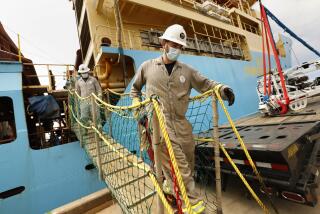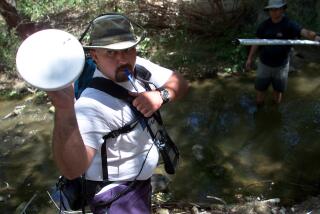Willard Bascom; Pioneer Oceanographer, Explorer, Controversial Researcher
Willard Newell Bascom, engineer and oceanographer who pioneered deep-sea exploration in a continuing search for tin, gold, diamonds and history and became a controversial researcher on pollution in Santa Monica and San Pedro bays, has died. He was 83.
Bascom, formerly with UC San Diego’s Scripps Institution of Oceanography and later the Long Beach-based Southern California Coastal Water Research Project, died Sept. 20 at his home in La Jolla. According to his daughter, Anitra Bascom, he died of complications from an infection he developed from injuries suffered in a July 26 automobile accident.
Writer, painter, photographer, cinematographer, miner, archeologist and iconoclastic scientist, Bascom joined Scripps in 1951 and set out to sea with the revolutionary Capricorn Expedition. Exploring the bottom of the equatorial Pacific Ocean, Bascom and others gathered information about the Earth’s crust that formed the basis for the geological theory of plate tectonics.
Diagnosed with bone cancer during the expedition, Bascom was said to take unusual risks, theorizing that he had only a few months to live and one chance to make his mark. But he subsequently subjected himself to unusual doses of radiation and conquered the cancer.
Leaving Scripps in 1954 to become technical director for the National Academy of Sciences in Washington, D.C., Bascom organized and directed Project Mohole, the pioneering attempt to pierce the Earth’s crust. Using an oil-drilling ship off the coast of Mexico near Guadalupe Island at a time when the record depth of water in which drilling had been done was about 400 feet, Bascom drilled under 11,700 feet of water to obtain the first samples from what he called the Earth’s “second layer.”
Author John Steinbeck went along and wrote about the startling scientific adventure for Life magazine. Bascom himself detailed the Mohole experience, which later was abandoned by Congress because of its cost, in his 1961 book, “A Hole in the Bottom of the Sea: The Story of the Mohole Project.”
The many-faceted Bascom, once a mining engineer, shifted direction in 1962 to form Ocean Science and Engineering Inc., and a decade later Seafinders Inc. He used his deep-sea drilling expertise first to search for diamonds for the De Beers company off the coast of South Africa, and later to locate ancient shipwrecks.
His work took him around the world, including rivers in Vietnam during the war there. And in 1962, according to a secretive civil case he brought in San Diego more than a decade later, he proposed a daring plan to the Air Force and the CIA for raising sunken Soviet missiles. Bascom’s suit claimed he had patented the method. His plan was rejected, but his ideas were applied by the controversial ship Glomar Explorer, which was discovered trying to salvage a Soviet submarine for the CIA in 1974.
Among the historic ships Bascom found were a Spanish galleon called the Nuestra Senora de la Maravillas, off the Bahamas; a wreck off Greece that produced three major bronze statues for the Greek National Museum in Athens; and the paddle-wheel steamer Brother Jonathan, sunk in 1862 off the coast of Northern California.
Bascom was a somewhat controversial figure in Los Angeles County from 1973 to 1985, when he served as director of the Southern California Coastal Water Research Project, funded by various city and county sewage districts. Often tangling with Assemblyman and later state Sen. Tom Hayden, whom he labeled an “extreme environmentalist,” Bascom worked to obtain waivers from the federal Clean Water Act for coastal cities. That act required “secondary” or advanced chemical treatment of sewage before it could be released into the ocean.
Unlike many scientists, Bascom maintained that the two bays’ water quality actually improved markedly from the mid-’70s to the 1980s and that neither DDT nor PCB levels there were toxic. The bays were technically contaminated, he said, but not dangerously polluted. Furthermore, Bascom took the controversial view that human food waste actually fed growing populations of fish.
“In Los Angeles, one-third of the sewage solid waste went through garbage disposals, food that we might have eaten,” he once said. “But whether the food went through us or around us, it makes no difference to sea animals.”
After one of his employees wrote Hayden criticizing Bascom’s research and reports in 1985, Bascom told The Times: “You’re putting food out, you’re feeding animals. You get a rise in the number of sea animals around these discharge pipes. The environmentalists hate to hear that, but it’s true.”
Furthermore, Bascom argued, taking expensive extra precautions to treat sewage discharged into the ocean could cause problems elsewhere in the Los Angeles Basin’s delicate ecosystem by increasing air and land pollution.
“Many color photographs of the bottom of the [Santa Monica] bay show it to be in excellent condition,” he wrote in a Times Op-Ed piece. “The calculated risk of getting cancer from eating bay fish is about 1/100th that of being murdered.”
A panel of scientists absolved him of charges that he had withheld information about the severity of toxic contamination in the bays and reprimanded his chief critic. But Bascom stuck to his previously announced plan to retire on July 1, 1985, and return to seeking lost ships and treasure.
As eclectic in his writing as in his exploration, Bascom wrote numerous scientific articles and the highly respected textbook “Waves and Beaches: The Dynamics of the Ocean Surface,” first published in 1963 and revised and expanded in 1980. But he also edited a 1969 volume, “Great Sea Poetry,” and wrote the 1976 book “Deep Water, Ancient Ships: The Treasure Vault of the Mediterranean.”
He wrote such documentary films as “Diamonds Under the Sea,” “The First Deep-Ocean Drilling” and “A New Harbor for Cape Town.”
Born in New York City, Bascom first ventured below the water as a teenager during the Depression while working on the Delaware Aqueduct tunnel. He attended the Colorado School of Mines, and although a disagreement with the president caused him to leave without graduating, the school later awarded him its Distinguished Service Medal. He also earned the Marine Technological Society Distinguished Service Award and the Explorers Medal, among others.
Bascom worked as a mining engineer in Colorado, Arizona, Idaho, New York and Washington state in the early 1940s and spent five years as a UC Berkeley research engineer before joining Scripps.
A widower, Bascom is also survived by a son, Willard Bernardin Bascom of Potomac, Md.; a brother, Bob Bascom of Paoli, Pa.; his companion, Susannah Haber of Del Mar; four grandchildren; and one great-grandson.
More to Read
Sign up for Essential California
The most important California stories and recommendations in your inbox every morning.
You may occasionally receive promotional content from the Los Angeles Times.









